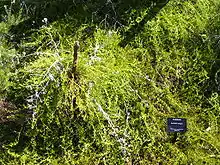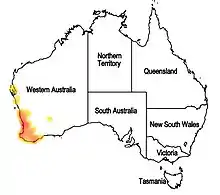Hemiandra pungens
Hemiandra pungens, commonly known as snakebush, is a shrub or trailing plant that is endemic to southwestern Western Australia.[3]
| Hemiandra pungens | |
|---|---|
 | |
 | |
| Scientific classification | |
| Kingdom: | Plantae |
| Clade: | Tracheophytes |
| Clade: | Angiosperms |
| Clade: | Eudicots |
| Clade: | Asterids |
| Order: | Lamiales |
| Family: | Lamiaceae |
| Genus: | Hemiandra |
| Species: | H. pungens |
| Binomial name | |
| Hemiandra pungens | |
 | |
| Synonyms[2] | |
|
Hemiandra brevifolia Benth. | |
Description
Ranging in height from 5 cm to 100 cm, it occurs on rock outcrops.[3] It is a variable species that may form a trailing plant or a small shrub.[4] The spotted flowers may be white, pink or bluish-purple and appear throughout the year.[3] It flowers in the spring.[4]
Taxonomy
The species was formally described in 1810 by Scottish botanist Robert Brown.[4]
A widely cultivated variety lacking hairs on the stems and leaves is sometimes classified as a variety (Hemiandra pungens var. glabra),[4] or by some authors as Hemiandra glabra,[5][6] or treated as a synonym of Hemiandra pungens.[7][8]
Cultivation
H. pungens seed is not typically available but this species is easily propagated from cuttings of other plants. It can be grafted onto related species including Westringia fruticosa. It can be grown in containers such as hanging baskets, and it performs best in dry climates without humid summers, in a sunny, well-drained area.[4]
References
- "Hemiandra pungens R.Br". Australian Plant Name Index (APNI), IBIS database. Centre for Plant Biodiversity Research, Australian Government. Retrieved 10 February 2014.
- "Hemiandra pungens R.Br. | Plants of the World Online | Kew Science". Plants of the World Online. Retrieved 2020-08-03.
- "Hemiandra pungens R.Br". FloraBase. Western Australian Government Department of Parks and Wildlife.
- "Hemiandra pungens". Australian Native Plants Society (Australia). Archived from the original on 22 February 2014. Retrieved 10 February 2014.
- "Hemiandra pungens var. glabra (Benth.) Benth. [ nom. illeg. ]". Australian Plant Name Index (APNI), IBIS database. Centre for Plant Biodiversity Research, Australian Government. Retrieved 10 February 2014.
- "Hemiandra glabra Benth". Australian Plant Name Index (APNI), IBIS database. Centre for Plant Biodiversity Research, Australian Government.
- The Plant List, vers. 1, 1, 2013, access date 18 November 2015
- "Hemiandra glabra Benth". Plants of the World Online. Royal Botanical Gardens Kew. Retrieved 2018-11-04.